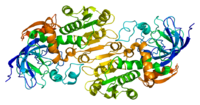
Photo from wikipedia
At the anode, the electrochemical oxidation of β-nicotinamide adenine dinucleotide hydrate (NADH) to its oxidized form (NAD+) spontaneously proceeded using photo-excited flavin mononucleotide (FMN) as the redox mediator. At the… Click to show full abstract
At the anode, the electrochemical oxidation of β-nicotinamide adenine dinucleotide hydrate (NADH) to its oxidized form (NAD+) spontaneously proceeded using photo-excited flavin mononucleotide (FMN) as the redox mediator. At the cathode, H+ ions were electroreduced to produce H2 gas. By introducing both ethanol biofuel and alcohol dehydrogenase to this photogalvanic cell, the cell current continued to flow, because NAD+ was converted to NADH by the biofuel and the enzyme. This cell provides not only electricity, but also H2 gas as by-products. This is an advantageous feature which common enzymatic fuel cells do not possess.
Journal Title: Journal of Electronic Materials
Year Published: 2020
Link to full text (if available)
Share on Social Media: Sign Up to like & get
recommendations!